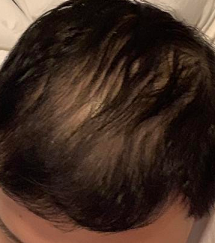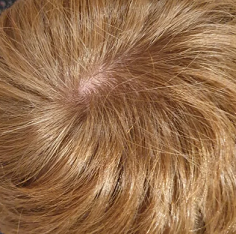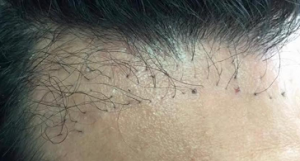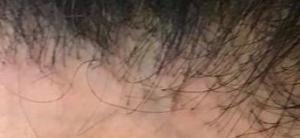I saw this man in my office. He had a persistent strong frontal hairline and hair loss is behind it. He comb-over this balding area. He doesn’t fit the classic hair loss patterns described by Otar Norwood who didn’t define persistent frontal hairlines (they are rare). Medical treatment with minoxidil and finasteride might be the best approach for the loss in the center of his head. I would not rush to a hair transplant at this point in time as he was under 25 years old.
Finasteride works just to stop or slow hair loss and in these situations you often don’t see much until you stop it when, if I am correct, you will see rapid withdrawal hair loss. Dutasteride is not a magic bullet and it has sterility risks in men and it is not FDA Cleared.
If this is recent, it is may be early genetic balding
My barber noticed my hair thinning from the front, but didn’t see it as a serious sign of balding. Are there any scalp masks and serum oils to regrow my hair? from tressless
I’ve been slowly thinning and receded hairline since my early twenties. I’m now 37 and probably about a NW 2.5. I think it’s time to seek professional advice. Firstly, to officially diagnose what type of hairloss I have, to tell me how bad it will get and what my options are.
My question is, what is the best way to seek this type of help. Should I go to a GP and ask for a referral? Should I pay to see someone private? I’m thinking it’s not a good idea to go to a hair clinic, because they might try and sell me something against my best interests
You should find an expert in the field of hair loss. It might be a hair transplant surgeon like me, or a local dermatologist who has an interest in the hair field (many don’t). A proper diagnosis include video microscopy, HAIRCHECK instrument checks when appropriate, a good hair and scalp examination and a doctor willing to spend time with you to answer your questions.
Because the actual work takes often many people, the work load is distributed to technicians; however, the doctor must do the following: (1) give the anesthetic, (2) do all of the surgical planning including the design and distribution of the grafts, (3) make determinations on the size of the strip (if a strip surgery is one) or the instruments that are appropriate if FUE is done, (4) Perform the strip surgery or the FUE which includes the extraction of either the strip or the FUE coring component, (5) Orchestrate the individual’s roles, control quality of graft management among the staff who prepare the grafts and may insert them into sites made by the surgeon (site making must be done by the surgeon)?
Your examination showed that your hair is fine (measuring 40 micron thickness), has a salt and pepper color, is straight from what I can see, and your scalp laxity (the looseness of your scalp) is very good. I spent some time explaining that the area of balding you have now, was originally covered by 75,000 hairs. With the hair remaining around the back and sides of your head, only about half of it can be moved to cover this large bald area. I can move possibly between 10,000-15,000 hairs in two surgeries to cover an area that originally was covered by 75,000 hairs, so that the new density will be 1/5th or the original at best. As your hair is fine, the value of each hair is less than if it would have been coarser and does not cover very well without a substantial numbers which you will not get from the two surgeries I am recommending for you. I showed you many pictures today including someone with fine hair who had front and top coverage and expected that this is what you would look like, and you told me you would be satisfied with this look. I also discussed that when the hair is fine, longer hair gives you better coverage so when it starts to grow in after the hair transplant, you will make determinations at that time as to what length looks best.
I recommended at least two surgical sessions with as many grafts as possible and as are safe. The first session will get out between 2500-3000 grafts and the second session will be another 2500-3000 grafts (each graft contains about 2 hairs). If after the second surgery has grown in (about 6-8 months after), then we will make a decision about how full it is, if it meets your goals and if you want it to appear fuller, either a third hair transplant or Scalp Micropgimentation (http://www.scalpmicropigmentation.com) to color in the background), would be the next and possibly last step in the process.
I told him that I was confident that we would achieve the goals he and I defined if he followed the plan I outlined for him.
With no vellus hairs seen, this is a clear indication that there is some scalp and hair disease present (Frontal Fibrosing Alopecia, or Lichen planopilaris which typically presents as smooth white patches of scalp hair loss. No hair follicle openings can be seen in the areas of hair loss. At the edges of these patches, there may be scale and redness around each hair follicle. Hairs can be easily pulled out. This condition is a contra-indication for a hair transplant. A scalp biopsy will help make the diagnosis.
If you are 19, neither the surgeon nor you know what is going to be your final hair loss pattern so decisions made at 19, mean (1) possibly using up your donor bank of hair, (2) having a hair transplant every year as your balding pattern progresses which is does in many young men. When a man reaches the age of 25, their hair loss pattern is often evident and knowing this allows the surgeon to make a Master Plan not only for the hair loss you have now, but for the future prediction of your hair loss from the diagnosis of your future loss pattern. Donor grafts must be saved for the future loss predicted by the surgeon at 25 years of age?
I am 25 years old suffering from hair loss . I had a FUE Hair transplantation of 2000 grafts for the hair line but the results was not full and I believe now that I need more hair in the top and the vertex area. Can I do another hair transplant?
Your surgeon should have made a Master Plan for you knowing your donor density so that your surgeon could then know if your donor density is adequate to support a second hair transplant. Sometimes a strip surgery may be better for the second hair transplant if the donor density appears to be thin from the first surgery?
I still have a full crown hair wise but you can clearly see the skin, the hairs are transparent, they have basically no pigmentation and that’s why it looks very thinning. What is the underlying science behind loss of pigmentation in AA? I couldn’t find any studies on the web
Miniaturized hairs often lose pigment and color because the hair follicle production is impaired and continues to get worse as the process progresses. As the hairs get thinner and thinner, they contain less pigment and eventually become clear (see-through) as the pigment cells in these hairs die. These hairs also often stop growing before eventually falling out completely.
Hi doctor, if I want to drop finasteride for cognitive reasons, is it better to slowly ween off of it, or drop it cold turkey? I’m 4 months in. I’m doing proscar 1.25mg every other day.
Just stop it! If you had benefits, you will see the benefits disappear in up to the first 3 months
Page 266 of 1241




 Click to enlarge
Click to enlarge
